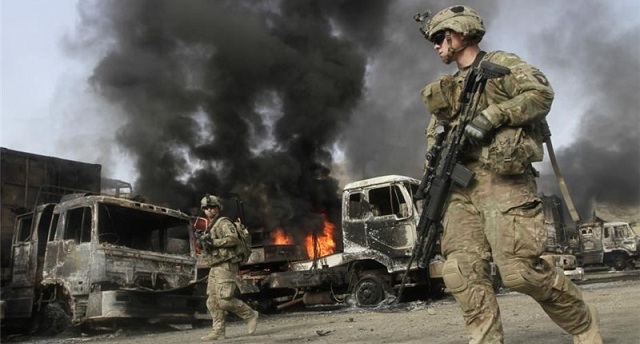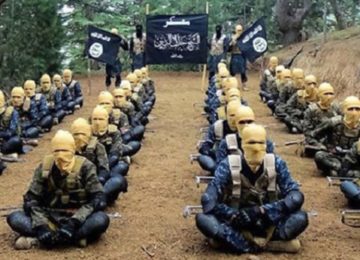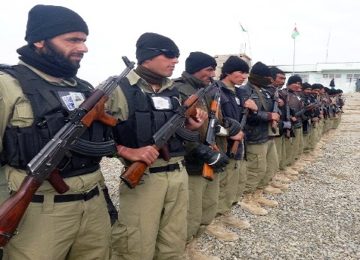Continuing our look back at key developments in Afghanistan in 2017, after migration and peace talks, we come to security. Tracking trends in security has become more difficult, as more areas suffering conflict have become inaccessible and those fighting – both Afghan and international –less transparent. However, AAN’s Thomas Ruttig has identified indicators to gauge what the trends were in 2017, compared both to 2016 and to 2014 when the character of western military involvement changed. He confirms that these trends show that the Afghan war became more violent and widespread in 2017.
Why measure security trends?
Measuring how successfully (or not) the post-2001 intervention in Afghanistan has gone so far requires an analysis of the country’s security situation. But fact-based information has become scarcer and because it is used in specific political contexts, that are often dominated by domestic political issues, particularly in the run-up to elections, interpretations of what data there is has become politicised.
One example is the discussion over Afghan security in the context of the large refugee movements of 2015/16 and whether it is safe for governments to deport rejected asylum seekers back to Afghanistan or not. Even though significantly fewer asylum seekers are now arriving in Europe, including from Afghanistan (AAN’s 2017 review of this topic here), this issue still dominates the discourse in many western countries, which are also troop contributors to the Resolute Support mission in Afghanistan. Several of them have recently further tightened asylum laws and practice.
In Germany, for example, the government in Berlin came under heavy public pressure over the entire period from 2015 to 2017 about how it steadfastly denied any deterioration in Afghanistan’s security situation in order to justify deportations. (1) When even governments of some of the German federated states (Länder) expressed doubts about whether that correctly reflected reality, Berlin turned to the United Nations refugee agency, the UNHCR, to get a third opinion in the autumn of 2016. When the UNHCR sent what a leading German weekly, Die Zeit from Hamburg, called a “diplomatic but nevertheless unequivocal” rejection of the official German position, Berlin chose to ignore this and stick to its own position. (2)
The German debate was not made easier by the fact that most government reports relevant for the topic, including the one with the original October 2016 assessment, are classified. This is also the case in other European countries. In Germany, they are only made accessible to members of parliament and parties involved in asylum court cases. (The government argues that informing the members of parliament was informing the public, as they had been elected by it.)
The available information: fewer sources, less transparency
For many years, the international military in Afghanistan – ie the US/NATO-led ISAF mission – provided regular and comparable public information statistics on the war, for example about the number of enemy-initiated and other security incidents in the country (in the AAN archive; see also this AAN report on one aspect of them). In 2013 it chose to not release this information any longer (see AAN reporting this here). (Its regularly publishing of the number, origins and distribution of NATO and allied troops in the country did continue, see archive of the so-called ISAF placemats, that were published almost monthly, here.)
As to the other main actors in the conflict, Afghan government forces have only ever provided information on security incidents and casualties piecemeal and irregularly. The Taleban have been publishing a stream of ‘incident reports’ over a number of years and for the first time, at the end of 2017, these were put into a web-based report titled “Afghanistan in the year 2017.” But it does not summarise the number of claimed attacks and casualties caused.
Detailed and regular public reporting by NATO and US forces partly stopped and partly significantly slowed down after the ISAF mission was closed on 31 December 2014 and replaced by Resolute Support. The new mission is significantly smaller than ISAF and has a more limited mandate – now without a combat element and concentrating on training, assisting and advising exclusively. (3) The US military alone is also involved in a ‘can be combat’ mission, Freedom’s Sentinel, so does have more personnel on the ground. NATO argues that, after the so-called ‘security transition’ to an Afghan lead, its responsibility to report officially ended and this was now the responsibility of the Afghan authorities. (4) Without ISAF’s Provincial Reconstruction Teams that had existed in most provinces (here a list from 2010 and more details tables and a map in this undated NATO handbook, pp 99-112), it did indeed become more difficult for NATO to collect its own first-hand information on security incidents around the country.
This argument, though, only carries that far. Command and control as well as intelligence gathering and analysis structures remained (the ISAF headquarters was basically just relabelled), so that RS clearly has a capacity also for reporting. The US component of the international forces clearly still has some capacity, as the reports of the US Special Inspector General for Afghanistan Reconstruction (SIGAR) show; they regularly feature figures provided by the US military. The US military also regularly issues reports to Congress on “Enhancing Security and Stability in Afghanistan” that are publicly available and contain some figures that can be used for establishing indicators (the most recent report, released in December 2017, here). This report says that “the coalition relies largely on [Afghan armed forces] reporting for all metrics.” (5)
After ISAF’s decision, other entities – such as the Afghanistan NGO Safety Office, now the International NGO Safety Organization (INSO) used also to regularly and publicly report security incidents, but took their quarterly assessments out of the public sphere in 2013. They felt their data had become the subject of protracted discussions that could endanger the providers of their information, namely NGOs in the field, the protection of which (and not providing public information), was ANSO/INSO’s mandate.
The UN continues to regularly provide various data in publicly available quarterly reports from its Afghanistan Special Representative to the Security Council (UNSC) and in its humanitarian agencies’ reporting. It does not state what sources it uses in the reports to the UNSC, but it can be assumed that it is provided figures from the US military and Afghan government.
Apart from this, the European Asylum Support Office (EASO), a European Union organisation, provides extensive data down to the district level in its annual “Country of Origin Information Report” on Afghanistan’s security situation (most recent one published in December 2017, here). Geographically, its breakdown goes beyond the UN and US data, which is usually region-specific only. (Afghanistan’s security forces are structured along eight regions comprising several provinces each.) EASO also uses a lot of open-source information from media and think-tanks, as well as some classified data. It also interviews experts. In its most recent report, however, EASO has not reported in full years when it comes to numbers of incidents. This makes it difficult to compare its data, for example, with the UNAMA reports, whose reporting period starts on 1 January. Also it allows only limited comparability with EASO’s own reports from earlier years.
Importantly, it is clearly stated in EASO’s 2017 report that “this document does not claim to be exhaustive. If a particular event, person or organisation is not mentioned in the report, this does not mean that the event has not taken place or that the person or organisation does not exist.“ This hints at the possibility that there could be for example, an unknown number of unreported security incidents.
What indicators?
In the face of shrinking publicly available data, it is necessary to compile and assess what is there, particularly that which is published at regular intervals, meaning it can be used to identify trends over time, and to identify indicators that are meaningful. We suggest having five such indicators: (6)
- The number of security-related incidents
The number of incidents is a key direct indicator reflecting the intensity and geographical spread of the fighting in the country. ‘Incidents’ include military activities by all parties in the war such as air strikes or ground engagements, such as battles and ambushes, what the UN call ‘complex’, bomb and IED attacks’, assassinations and other types of violence (these categories can overlap), but also abductions and the discovery of weapons depots etc. (7) On this indicator, regular data is still available, despite the growing silence on the military side, for example from the UN and EASO.
In the US military’s reports (see for example here), it is argued that “effective enemy initiated attacks” (ie those that result in casualties) are “the most representative metric of overall security conditions rather than the total number of reported security incidents” as the Afghan forces “often do not report insurgent attacks that do not result in casualties” [Italics by AAN]. But this particular kind of attack is not regularly provided in those reports. Given this method of measuring, the total will be a portion of a larger total of insurgent attacks (a figure not given in the US reports), as it excludes those that were ‘ineffective’.
Sub-categories of this indicator could include the number of airstrikes and dropped ‘munitions’ or ‘weapons’. There may also be a sub-category of enemy-initiated and pro-government forces initiated attacks.
- Civilian casualties figures
The figures for Afghan civilian casualties are regularly reported by UNAMA, every six months with short quarterly updates, in its ‘protection of civilians’ reports. It provides breakdowns, and detail, in terms of the causes of casualties and the source (pro or anti-government forces); it also gives gender and adult/child breakdowns and regional trends. Similar to the US reporting of the number of ‘effective’ incidents, it can be expected here, too, that there is a grey zone, ie a number of non- or ‘underreported’ casualties, as UNAMA only includes cases in its reports that have been verified by “at least three different and independent types of sources, i.e. victim, witness, medical practitioner, local authorities, confirmation by party to the conflict, community leader or other sources” (see here). (8) UNAMA’s figures are also used in all above-mentioned US and EU reports.
There are also Afghan organisations and media who collect and publish figures about Afghan civilian casualties (see more below).
Sub-categories that could also be used include incidents of violence against Afghan media workers and aid workers (both Afghan and international). These are regularly provided by Afghan and international watch dog organisations.
- Afghan armed forces casualties figures
These figures had been consistently reported by the US military to the SIGAR, although they have rarely been provided to the public directly. These have now also become a victim of curbs on transparency. As the SIGAR revealed in his July 2017 report, the US forces in Afghanistan have, “at the Afghan government’s request, […] classified or otherwise restricted information about the ANSF’s performance.” (9) Apart from the casualty figures, this applies to “personnel strength, attrition, capability assessments, and operational readiness of equipment.” (The US government has also decided not to publish exact figures on the additional troops it is sending to Afghanistan in the framework of the Trump strategy – see here, p 19.)
- The number of conflict-related Internally Displaced Persons (IDPs), ie those who temporarily or permanently have had to leave their homes as a result of fighting or other violence without crossing international borders
These figures are regularly provided now by UNOCHA.
- Territorial control
This refers to the ratio of control over territory by both Afghan parties of the war, the government in Kabul and the Taleban. How this can be measured exactly is a hotly debated issue, and the situation is relatively fluid. Different organisations apply different criteria. (10) As we are looking for a trend, however, even data sets the criteria of which could be disputed in detail but appear sufficiently reliable in themselves, are useful as long as they are comparable. Therefore, this analysis relies on the figures provided by the SIGAR reports which use US military data and public sources, such as from the UN. (Also, the resulting trends of other sources from their data compilations do not differ substantially from that of the SIGAR reports.) However, this data has only been published starting from December 2015 and only gives an overview of the post-ISAF period (see here, p 106).
About his methodology, the SIGAR reported in his April 2016 quarterly report, p 95-6:
According to USFOR-A [US Forces in Afghanistan], the RS mission determines district status by assessing five indicators of stability: governance, security, infrastructure, economy, and communications.
Using those criteria, five categories have been introduced there: under insurgency control; under insurgency influence; ‘neutral’ (meaning rather that both sides are more or less equally strong); under government influence and; under government control. ‘Influenced’ should be read as ‘predominantly controlled’. ‘Neutral’ was changed to ‘contested’ in the third quarter of last year (here, p 106), as SIGAR explained: it was not clear “whether these [contested] districts are at risk or if neither the insurgency nor the Afghan government exercises any significant control over these areas.” (We discussed what ‘territorial control’ means earlier, in these AAN dispatches, here and here.)
As the terrorism watch website The Long War Journal correctly explains, somewhat differing from the SIGAR definition (here):
… a “Contested” district means that the government may be in control of the district center, but little else, and the Taliban controls large areas or all of the areas outside of the district center. A “Control” district means the Taliban is openly administering a district, providing services and security, and also running the local courts.
A more detailed look into territorial control would need to measure factors such as access for government services, humanitarian aid and development assistance, the physical presence of a district governor or administration in the district centre and the presence of Taleban institutions.
Applying the indicators
Not only the number of security incidents, but also those of civilian casualties, IDPs and territorial control reflect the intensity and geographical spread of the fighting in the country. (Afghan forces’ casualty figures have been given per region or province in the past.) The number of incidents alone is only a quantitative indicator, as all incidents are given the same weight, ie the assassination of one individual carries the same weight as a bomb attack with dozens of casualties.
The qualitative intensity, or severity, is more difficult to measure. UNOCHA has produced a map, based on the three indicators security incidents; civilian casualties and conflict induced displacement, reproduced in the EASO report (here, p 63). Relying that strongly on incidents figures still does not give the full picture.) It makes more sense to put them in context with other indicators to get closer to adequately describing Afghanistan’s security trend.
When assessing the trend, governments – such as the German one in its asylum-related reports – often only compare the current year or a certain period of it with that of the previous one. This only gives a short-term perspective and can be misleading about the trend. It is more useful, rather, to take a longer-term perspective and at least go back to the 2014 ISAF/RS transition which constituted a game-changer with regard to the key factor of how many foreign troops were on the Afghan ground and what their mandate was. (The mission for US troops only has been expanded and altered several times, since 2015 – see AAN analysis of the Trump strategy here, the ‘Nicholson plan’ here and the role of the CIA, here.)
It is impossible to go back to 2001 with most of our indicators as, for example, UNAMA started counting and reporting civilian casualties only in 2009 in a systematic manner (although there were some reports before that). As AAN reported earlier, there is also no full data set on IDPs between 2001 and 2009.
Indicator 1: the number of incidents
The latest full-year database available for this indicator is from 2016 from UNAMA’s annual report published in March 2017. Noting that “The overall security situation continued to deteriorate throughout 2016 and into 2017,” it reported 23,712 security incidents, “an almost 5 per cent increase compared with 2015 and the highest number in a single year ever recorded by UNAMA.”
EASO, in its latest report, only covered the period between 1 September 2016 and 31 May 2017, leaving out the usually most active summer months. Over the nine months covered, it came up with 17,779 conflict-related security incidents (we have subtracted the non-conflict related and ‘other’ ones from the EASO tables) in what it explicitly called “not (…) an exhaustive list of incidents.” If we add, conservatively, one quarter (4,445) to the EASO figure, we would arrive at 22,224, approximately confirming the level of the UN figures.
In early 2015, the UN reported that the 2014 figure – the last year before the transition from the ISAF to the RS mission – with 22,051 recorded incidents had surpassed the 2013 figure by ten per cent.
For the past year, it had registered 21,105 incidents by 15 November 2017, another one per cent increase, compared to the same period in 2016.
The figures above together indicate that the number of security incidents has increased by over ten per cent since the last year of the ISAF mission. For the present, the curve has flattened (ie the rate of increase has substantially decreased), but even if there were no increases between 2016 to 2017, this would constitute a plateau at the highest level since 2001.
Afghan Ministry of Defence figures reported by Afghan media in November 2017 corroborate this trend. According to this information, insurgent activities were up by 13 per cent in the current year that far, compared with the same period of 2016.
The UN also reported that the conflict “spread in geographical scope.” This is not withstanding the finding that 50 per cent of “all incidents recorded” occurred in five provinces, Helmand, Nangarhar, Kandahar, Kunar and Ghazni. Given the total figure, this would still amount to over 400 security incidents on average that year in the remaining 29 provinces.
Furthermore, the report makes the important point that the 2017 trend “reinforced the shift in the conflict evident since earlier in the year, away from asymmetric attacks towards a more traditional conflict pattern characterized by often prolonged armed clashes between government and anti-government forces.” This speaks for a qualitative escalation also of the war.
Find all “Report[s] of the Secretary-General: The situation in Afghanistan and its implications for international peace and security” to the UN Security Council here and all his briefings to the Security Council here.
As a subcategory of the number of incidents, the number of American, but not Afghan airstrikes and ‘weapons released’ can be used. There are various US sources, such as the quarterly Operation Freedom’s Sentinel (OFS) reports. The most recent one, covering the period of July to September 2018 has figures for 2015 to 2017 and shows a slow, but almost steady rise up to the second quarter of 2016, with some ups and downs, followed by figures peaking in the third and fourth quarter of 2017; they are double or as high as in the immediately previous quarters (see here, p 29). (11) (Afghan and US airstrikes were together responsible for six per cent of civilian deaths and injuries in the first three quarters of 2017, according to UNAMA).
Find all OFS semi-annual reports here.
Indicator 2: Civilian casualties
Since it started counting and reporting systematically in 2009, the UN has identified 27,481 civilians killed and 50,726 others injured by 30 September 2017, bringing the total casualty figure to 78,207.
The US-based Brown University’s Costs of War Project has undertaken to cover the whole period of the post-2001 Afghan war. Using available public sources for up to 2009 (see here, appendix B) and UNAMA figures thereafter, it estimated that more than 31,000 Afghan civilians were killed between 2001 and August 2016.
UNAMA has measured the total annual figures of civilian casualties increasing year on year, with one exception, a drop by 3.2 per cent from 7,842 in 2011 to 7,590 in 2012. From 2012 to 2014, the figure grew significantly by a quarter, and from then onwards to 2016 by slightly under five per cent per year. The 2016 figure (the latest complete data set available for a full year so far; the 2017 UNAMA report is expected in February 2018) had 11,418 casualties, including 3,498 killed and 7.920 injured. In this trend, there were stronger relative fluctuations among the categories ‘killed’ and ‘injured’ with one dropping possibly over a period and the other one increasing, or vice versa.
UNAMA’s latest quarterly (published in October 2017) had a slight change in the trend. In the first nine months of 2017, the total casualty figure dropped by six per cent compared with the same period in 2016, to 8,019, of them 2,640 dead and 5,379 injured. But this drop came after another “record year,” the UN said, and masked a one per cent increase in the number of civilians killed. Their number was then still at the highest level ever recorded.
This indicator reflects an almost unbroken escalation of the Afghan war.
Find all UNAMA reports on civilian Afghan casualties here.
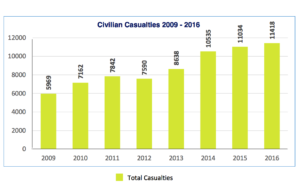
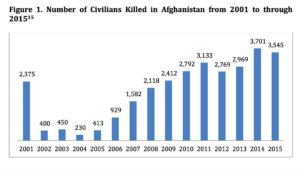
There are other counts and estimates of casualty figures of the Afghan war. The Afghanistan Independent Human Right Commission (AIHRC) is also regularly monitoring and reporting on civilian casualties. Its last report was disseminated after the last Afghan New Year (20 March 2017) and covers incidents in 1395 (21 March 2016 to 20 March 2017, here).
The AIHRC figures differ from UNAMA’s, due to the organisation’s different methodology. It says in its report that it attempts “to register and document all cases” that cause civilian casualties by on-the ground activity, ie “speaking to casualties and eye-witnesses,” but also says this can be limited by “security and logistic reasons.” At the same time, with eight zonal and six provincial offices, AIHRC is slightly better situated then UNAMA with its six offices.
UNAMA reported a slightly higher total of 11,418 civilian casualties than the AIHRC for 2016 which overlaps largely with the Afghan year of 1395. Due to the use of different calendars starting on different days, comparing both data sets is somewhat difficult. (UNAMA uses the Gregorian and the AIHRC the Persian solar calendar.) However, the reported general trends seem to confirm each other. Like UNAMA, the AIHRC also registered (see report, link above, p15) an increase in the total civilian casualties from 1393 (March 2014-March 2015) to 1394 (March 2015-March 2016) to 1395, from 7,005 to 9,431 to 10,608. At the same time, the AIHRC registered a slight drop in people killed from 3,129 (1394) to 2,823 (1395), ie by almost ten per cent. But the number of injured climbed by 23.5 per cent in the same period.
Like UNAMA, AIHRC does not report casualty figures by province, but by region. The AIHCR’s new report will come out in spring 2018.
Afghan media such as Pajhwok Afghan News have started publishing monthly reports a few years ago, but in January 2018, for the first time, it published an annual figure of what appears to cover all people killed, ie civilians and fighters of all sides. (It simply speaks of “people killed [and] wounded.”) According to this, “14,600 people have been killed and 10,277 others injured in 2,050 various attacks last year.” From this, it calculated a casualty rate of 86 people per day on average. As a data base, the agency used its own reporting, “Pajhwok Afghan News’s disseminated reports from different sources.”
Pajhwok concurs with UNAMA in some key findings: that most casualties were caused by direct combat, but that airstrikes were the most deadly single type of attack, resulting in a “high[er] number” of casualties per incident. It also reported that over half of all casualties were counted in five provinces (Nangrahar, Kandahar, Helmand, Kabul and Uruzgan, closely followed by Faryab, Ghazni, Jowzjan, Farah and Paktika). On the opposite end of the scale were Badghis, Samangan, Bamyan and Panjsher. Panjsher (one case) and Bamian (two cases) also accounted for the lowest number of “attacks,” while Daikundi had zero.
The Civilian Protection Advocacy Group (CPAG), an NGO umbrella group – based on an apparently more limited data base – counted 1,370 Afghan civilians killed and 2,360 others wounded in the last eight months of 2017. (12) The CPAG announced its findings on 10 January 2018. It said it recorded most casualties in Kabul, Nangarhar, Herat, Ghor, Kunduz and Helmand provinces and that most of the causalities resulted from suicide bombings, airstrikes and ground operations. Most casualties from US forces’ airstrikes occurred in Nangarhar, Herat, Kunduz and Uruzgan; in total, it said, 62 Afghans were killed and 167 injured this way. (Find the full report here).
The UNAMA figures indicate a steady rise in the number of civilian casualties since 2009, interrupted only once in 2012 compared with 2011. It can be expected that this trend will continue, although it might have reached a plateau in 2017, as the number of incidents had almost done so by November 2017. None of the other figures contradict this conclusion, in any way.
Other data bases reporting on subsets of civilians – such as aid workers and journalists – map somewhat similar trends. The 2017 report of the Aid Workers Data Base, reporting incidents globally in 2017, ranked Afghanistan, with 25 cases ranging from kidnapping to killing, the second most dangerous country for aid workers to work in, in the world. The number of incidents had grown almost year on year from one case in 1997 to 81 cases in 2013 which was the worst year in this category. It seems that with the reduction of western troops, according to the Aid Workers Data Base, also the number of cases where aid workers were harmed dropped (to 25 in 2016). Still, Afghanistan remained the second worst country when counting incidents (again after South Sudan).
As to journalists, one leading Afghan media watchdog, Nai, has just released its 2017 report in which it calls the past year “the most deadly” for local journalists so far, in terms of deaths and injuries, a conclusion reached also by the Afghan Journalists Safety Committee (AJSC) (see this report released on 11 January 2018. Counting all incidents of violence against journalists, which includes harassment by the government, pro-government militias or commanders as well as by insurgents groups, Nai wrote, 2017 was the second violent year, after 2016.
Indicator 3: Internally Displaced Persons (IDPs)
The number of conflict-related Internally Displaced Persons (IDPs) has also increased since 2014, according to other UN data. UNOCHA spoke of an “absolute record growth” in their numbers in 2016 by 660,000. In 2017, there was another strong increase by 403,300 persons but the 2016 was not reached again (by 17 December 2017, see here; up to 448,069 by 8 January 2018, see here). After a drop from the record high in the last quarter of 2016, the number of IDPs rose again almost every month between February and November 2017, with a small decrease in December (although that month’s was still the second highest in 2017).
Apart from the Central Region (Hazarajat), with 192 displaced up to 8 January 2018, all other regions registered five- or six-digit IDP numbers. There were Afghans displaced by fighting or other forms of violence in 31 of 34 provinces and 219 of 399 districts while all 34 provinces had to accommodate IDPs. This confirms the countrywide spread of frequent fighting.
Before, between 2013 and 2016, IDP numbers had tripled. From 2012 to 2014, annual figures were under 200,000 (2012: 102,715; 2013: 122,815; 2014: 196,154), shooting up to about 470,000 in 2015 (see AAN analysis here). This means, the 2016 record followed on another one in the year before.
Although the number of new IDPs in 2017 was lower than in 2016, numbers are accumulating. While many IDPs return to their places of origin, the UN highlighted in its September 2017 report to the Security Council (here) that many “displaced communities” are living in an “increasingly precarious situation with no immediate prospect of returning to their areas of origin.”
[Amendment 31 January 2018: The total IDP figure by 31 December 2016 was given with 1,553 million people (here).]
UNOCHA’s very frequently updated website with location maps can be found here.
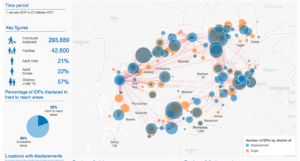
IDPs in Afghanistan (period of 1 Jan 2017 to 17 Jan 2018), source: UNOCHA (screenshot)
Indicator 4: Combat losses of Afghan government forces
The last year for which there are published figures for Afghan National Security Forces losses is 2016. SIGAR, based on Afghan figures, said 6,785 ANA and ANP members were killed and a further 11,777 wounded for the period between 1 January and 12 November 2016 (a total of 18,562 (here). Unpublished NATO figures seen by AAN counted 8,146 dead and 14,278 injured (22,424 casualties in total), for all of 2016. Casualty figures for 2017 are available for 1 January to 8 May. SIGAR in its July 2017 report, gave figures of 2,531 dead and 4,238 injured (6,769 in total) in the first quarter of that year. If the casualty rate was not brought down, those figures indicate that the total casualties for last year would be substantially higher than in 2016. Afghan media and individual Afghan journalists reported about 800 ANSF dead in September (read here) and 1,800 in October 2017 alone (13), which would also indicate a rise in the casualty rate in 2017 compared with 2016.
The 2016 NATO figures amount to 61 casualties a day, double that of the UN-recorded civilian casualties. The SIGAR called this casualty rate “shockingly high,” “unprecedented” and “unsustainable,” adding that figures provided to the US military by the Afghan authorities might still be “inaccurate,” and most likely “underreported.”
Those higher ANSF casualty figures not only indicate that the Afghan war has intensified further, they also reflect the UNAMA finding that the conflict is also qualitatively more violent.
At the same time, international forces’ casualties dropped, after their move to a largely non-combat mission and a drastic reduction in numbers during the transition from ISAF (140,000 at its peak in 2010 to RS (some 11,000 US troops plus 6,635 non-US NATO and non-NATO contributing countries (by May 2017, here)). (14)
By the end of 2014, ISAF had reported the total of those killed-in-action as 3,485 – with highs during the US surge in 2009 (521), 2010 (711) and 2011 (566). The number of foreign military killed in action have since fallen, to 27 (2015), 16 (2016) and 17 (2017). In 2018, there has been one casualty so far (source). The drop in foreign military casualties does not reflect a change in the war’s spread and intensity, but a qualitative change in the character of foreign troop deployment.
All SIGAR Quarterly Reports can be found here.
Wikipedia also has a compilation of data on ANA and ANP casualties between 2002 and 2014, based on media and think tank reports, here.
All international and Afghan forces’ casualties (2001-15), source: Brown University (screenshot)
All dead and wounded in Afghanistan 2011-16, source: Brown University (screenshot)
Indicator 5: Territorial control
According to the SIGAR reports, the Taleban have expanded their territorial control or dominance during most of the post-2014, post-ISAF period. In his most recent report published in October 2017 (here, p 106), he states that:
The Afghan government’s district and population control deteriorated to its lowest level since SIGAR began analyzing district-control data in December 2015. (…)
According to USFOR-A [US Forces – Afghanistan], approximately 56.8% [231] of the country’s 407 districts are under Afghan government control or influence as of August 24, 2017, a one-point decline over the last six months and a more than six-point decline from the same period last year.
In October 2017, it said the insurgents – which now include the Islamic State Khorasan Province (ISKP) – ‘controlled’ 13 and ‘influenced’ 41 districts (13 per cent). This left 122 districts ‘contested’ (30 per cent). SIGAR added that it was “not clear whether these districts are at risk or if neither the insurgency nor the Afghan government maintains significant control over these areas.” Earlier that year, in February 2017, the insurgents had ‘controlled’ 11 and ‘influenced’ (ie dominated) 34 districts (11 per cent of all districts). At the same time, however, SIGAR also reported that the government had extended its control, with 97 districts fully controlled and 146 dominated (in total 243 or 60 per cent). The explanation is that the number of contested districts was squeezed slightly; they dropped from 30 (112) to 29 per cent (119).
The Taleban claimed higher numbers for themselves, in their 2017 report, published in January 2018,
… forty one districts of Afghanistan are completely under Mujahidin’s control, while tens of other cities and districts are mostly controlled by Mujahidin. As far as the enemy is concerned, they cannot move freely and do not feel themselves secure even in the areas under their control.
This might be exaggerated, although the second part of the statement accurately reflects the situation in many areas. Even the Long War Journal wrote, in October 2015 (here), that before the 2016 fighting season, “The Taliban [controlled] 35 of Afghanistan’s 398 districts and [contested] another 35” (ie higher numbers than SIGAR). It further noted, “It is likely that additional districts in Kunar, Nuristan, Paktia, Paktika, Khost, Logar, Wardak, Zabul, Ghazni, Nimruz and Kandahar are Taliban administered or contested.”
According to the SIGAR reports (here, p 69 and here, p 89), most Taleban expansion came between November 2015 and November 2016 when the government lost about 15 per cent of the districts it had controlled or influenced to the Taleban. The number of those districts dropped from 292 to 233. Over the same time, the number of ‘contested’ districts rose from 88 to 133 (in 2015 still called ‘at risk’).
Districts under Taleban control and influence rose from 27 in November 2015 (not differentiated) to 41 in November 2016 (9 controlled, 32 influenced) and to 54 in August 2017 (13 controlled and 41 influenced).
At the same time, the US forces in Afghanistan reported that the part of the Afghan population living under Taleban control dropped from 2.9 to 2.5 million people from late 2015 to late 2016, resulting from the loss of more populated and gain of less populated areas. Based on the figure used in the report of 32.1 million Afghans, 2.5 million this would have represented under eight per cent of the population. Another 9.2 million (28.7%) lived in contested districts.
The same figures for August 2017, as reported by the US military in Afghanistan, was “3.7 million Afghans (11.4% of the population) liv[ing] in districts under insurgent control or influence. This is a 700,000-person increase over the last six months.” Another 8.1 million Afghans (24.9%) lived in contested districts.
By August 2017, the latest available SIGAR data, government numbers were at 231 (-2 compared to late 2016) under its control or influence and 122 contested (-11).
Control of the population has become a sensitive issue, given the US military’s belief that the government needs to control 80 per cent before the Taleban will be pushed to seek peace talks. (The OFS report cited above gives 2020 as a deadline for this goal.)
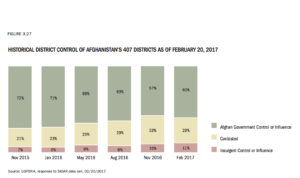
Control over districts in Afghanistan (government, Taleban, contested; Nov. 2015-Feb 2017). Source: SIGAR
In contrast to 2016 when the Taleban, for the first time since 2011, managed to take over a provincial capital, Kunduz, and to hold it for two weeks, they were unable to repeat such a success in 2017, although they reportedly intended to. At the start of the 2017 ‘fighting season’ after the Afghan New Year in March, Taleban spokesman Zabihullah Mujahed told the US daily Stars and Stripes (quoted here) that “there will be an increase in attacks in those provinces that are on the verge of collapse” over that year.
This, however, does not reflect a change of trend, as the Taleban continued to operate near a number of provincial centres and to keep them under pressure. This included Farah (the centre of which was facing take-over attempts three times in 2017, see for example this Guardian report, Kunduz city (again), Lashkargah (Helmand) and Tirinkot (Uruzgan) as well as Ghazni (see here, Sar-e Pul and Maimana (Faryab). For an analysis of other large scale Taleban operations in 2017, see this AAN analysis). The Taleban also control much of Maidan-Wardak and Logar provinces (read a reportage here) to the immediate south of the capital Kabul, have conducted larger operations in Parwan to its north and also operate in some rural parts of Kabul province. Finally, their underground terrorist networks frequently carry out suicide and ‘complex attacks’ in the capital. The local IS-affiliate, Islamic State Khorasan province (ISKP), as a relatively new terrorist actor in urban areas, adds to this threat. Its readiness to target large crowds of Shia Muslim Afghans has marked out a new sectarian trend in the Afghan war. But according to UNAMA’s 2017 mid-year report (the latest detailed data set, see here, p 33-5), the Taleban still eclipsed it both on the number of such attacks and the casualties they caused. (15)
Direct territorial control or dominance is just one dimension of the insurgency’s reach. The Taleban have also established parallel para-governmental structures, reports of which come up in the media only occasionally. Afghan media, for example, reported over the recent months that they systematically tax “media outlets, businessmen and common people“ and even “Provincial Council members [and] governor house officials“ all over Ghazni province, collect electricity fees in Kunduz and extort road tolls from truckers in Zabul. The Taleban are also building up networks of privately financed madrassas and mosques (see here in Helmand: and in Badakhshan). Their courts continue to operate, mediating in land and other conflicts (an example from Faryab), and maintain prisons (an example from Helmand). They impose changes on the school curriculum (an example from Logar) and influence the hiring and firing of teachers. It can also be assumed that they use government funding sent to schools operated by the Ministry of Education in Taleban-held areas (on such an arrangement, read this BBC reportage from Helmand). As the BBC report showed, the Taleban rule of parts of the province is so unchallenged that they can “focus on health, safety and trading standards.” In Uruzgan, they were able to temporarily close down 46 of the province’s 49 clinics in summer 2017, reportedly after their demand for special treatment for their wounded fighters was turned down. The Taleban have also started posting videos and statements in which they claim to organize road building and other infrastructure projects.
As scholar and former US official Barnett Rubin remarked in a tweet on the Ghazni report: “Who controls Ghazni if a radio station pays taxes to both government and Taliban?” It should have been known from the mujahedin’s fight against the Soviets, that it is problematic, in a guerrilla war (which Afghanistan still largely is), to try to draw a map which cannot but be static, while ‘front lines’ are extremely fluid and control of certain areas differs even between night and day. These maps can only provide some approximation of what control means. (The different methods and maps are also discussed in the EASO report, pp 63-7.)
Moreover, the insurgents, in particular, although organised in provincial and district structures, are often highly mobile and not held up by any district or provincial boundaries. In attack or retreat modus, they cross such boundaries with ease, while the more institutionalised structures of their adversaries (and particularly, in the past, of the multinational ISAF forces) are sometimes inflexible in responding to such flexibility. For example, the retreat of Taleban fighters from Faryab to Sar-e Pul (under the pressure of a self-declared Daesh commander) seems to have confronted the Afghan government forces with difficulties in how to coordinate their response (AAN analysis here). (16)
Concluding what the trend is
The five indicators for the intensity and violence of the Afghan war – security incidents, civilian and Afghan forces’ casualties, IDPs and Taleban territorial control – have shown mostly upward trends. If not any longer increasing, they showed that intensity and violence were close to having reached plateaus; levels were at their highest since data started to be collected, with the exception of additional conflict-related IDPs that was higher in 2016 than in 2017. This is definitely the case for the time since the withdrawal of most international forces by the end of 2014 and the ISAF/RS switch and, where data is known, usually from before that, too. Decreases have mainly been very slight and always temporary.
The UN has also made similar conclusions. In its 2017 strategic review of its mission in Afghanistan, it downgraded Afghanistan from a post- to an in-conflict country, stating:
The key observation regarding the current situation in Afghanistan (…) is that Afghanistan is not in a post-conflict situation, where sufficient stability exists to focus on institution-building and development-oriented activities, but a country undergoing a conflict that shows few signs of abating.
All parties to the conflict – the Taleban, the Afghan and the US government – are almost entirely focussed on the war (see AAN’s analysis on the absence of ‘peace talks’ in 2017 here) and achieving military advantage. (It is not just the US which is raising “the tempo of operations,” as an ICG analysis put it recently in 2018.) Given that, it can only be expected that, as the Afghan war approaches its fortieth anniversary, the voracity and possibly the geographical extension of the conflict may again increase this year – unless peace unexpectedly breaks out (our look at peace talks in 2017 give no grounds for hope). What happened during Obama’s surge of 2010 to 2012 could be repeated, that we see a mutually reinforcing spiral of escalation of the conflict.
In this piece, we have tried to assess the statistics of the Afghan war, while always aware that the data presented encapsulate into misery and loss. An escalation of the conflict would very likely push the five indicators we have considered up even further, translating on the ground into more lives lost, homes destroyed and hopes ruined.
—–
(1) It continues to claim there were ‘sufficiently safe’ areas in the country, including the terror attack-ridden capital Kabul. In its annual asylum-related situation report, in October 2016, it stated:
The security situation remains volatile. It differs regionally. There are regions where the situation is sufficiently under control and, for the individual, comparatively calm and stable.
It concluded that rejected Afghan asylum seekers could and should be sent back. For that purpose it hired a number of charter planes, and by the end of 2017, and including the first of this series in December 2016, had deported 155 Afghans.
(2) For example, the (then) Interior Minister of the northern state of Schleswig-Holstein, Stefan Studt, stated:
When Mr [Thomas] de Maizière [the federal Interior Minister] says there are safe regions, and I ask him where they are, and when I then do not get a precise answer, … then this is something where, as far as I see it, one has to say clearly that I can’t see this security.
Remarkably, Studt is a member of the German Social Democratic Party that is in coalition with Maizière’s (and Chancellor Angela Merkel’s) Christian Democratic Union. So, doubts about Berlin’s reading of the Afghan situation did not only exist among the opposition parties.
Here main points of the exchange of letters between the UNHCR, the German government and the Länder:
UNHCR wrote in December 2016,:
It is the view of the UNHCR that it needs to be considered when assessing the current situation in Afghanistan and the needs for protection of Afghan asylum seekers that since [UNHCR’s last assessment in] April 2016, the security situation has generally once more visibly deteriorated. (…) With a view at the regional differences in the assessment of the security situation in Afghanistan, the UNHCR would like to note that, because of the permanently changing situation […], it does not differentiate itself between “safe” and “unsafe” areas.(…) An over-generalising approach that, when it comes to the danger of human rights violations relevant for the protection of refugees or subsidiary protection, considers certain regions as safe and reasonable internal refuge alternative, is impossible in the view of the UNHCR, given the current situation in Afghanistan.
The German government, in a joint letter of its Federal Interior and Foreign ministries, nevertheless wrote to the states’ interior ministers that:
In general, the security situation in Afghanistan did not change significantly in 2016, compared with the previous year. As the statistics of the UN mission [in Afghanistan] UNAMA show (report dated 6 February 2017), the number of civilian casualties only increase slightly (by 3 per cent). […] Therefore, the assessment of the [German Federal Government’s] report on the asylum-related situation dated 19 October 2016 continues to be valid.
(Working translations by AAN. The original UNHCR statement here and the Interior Ministry’s letter here. Both are in German only.)
Sticking to the same line ever since, the German government has consistently rejected requests to publicly answer queries by media and even parliamentarians which areas exactly in Afghanistan it considers ‘sufficiently safe’. Even the classified reports do not name any provinces or other areas and contain hints at best.
(3) As AAN has repeatedly reported, there of course continues to be a parallel, and often shady, US combat mission, named Operation Freedom’s Sentinel (OFS) (see for example here.) OFS is also publicly issuing reports to Congress, with a classified annex (see the most recent one here).
(4) It needs to be noted that the security transition itself became less and less transparent, as insurgent activities did not falter after the 2010-12 US surge. As a result, certain areas (sometimes whole districts, sometimes only parts) were cut out of ‘transitioned’ provinces when it was felt that the Afghan forces could not withstand the insurgency on their own (see this AAN analysis and a particularly striking example here). This followed a trend in the transition becoming less and less ‘conditions-based’, in contrast to how it was originally designed (read this AAN report about it).
(5) There are also publicly available quarterly OFS reports (most recently from December 2017 here), but they contain no figures that are not available elsewhere.
(6) The Brookings Institution has developed its Afghanistan Index using 21 security indicators alone, plus economic, governance/rule of law, polling and “Pakistan indicators” (latest version from September 2017 here). In contrast to our approach, this index measures more general developments.
(7) This author suggests differentiating between attacks on targets that are considered legitimate of not under international humanitarian law, ie between attacks on combatants and civilians, including persons hors de combat.
EASO uses an even wider spectrum of incidents (see here, p 17), which include:
- Violent incidents targeting individuals: kidnapping, targeted killing, intimidation, harassment…
- Explosions: IED detonations, suicide bombings…
• Non-conflict related violent incidents: criminal activities, drug trade… - Security enforcement: arrests, discovery of weapons caches…
(9) The ANSF also include the Afghan intelligence service, the National Directorate for Security (NDS), with its own fighting units, but it is unclear whether the casualty figures also include NDS paramilitaries. Paramilitary forces such as the Afghan Local Police (under Ministry of Interior control) and pro-government militias are not included.
(10) Apart from The Long War Journal, maps on assumed territorial control have also been published by the London-based Institute for the Study of War; various ones are available on the Afghan Hindsight website, here).
(11) Figures of “effective enemy initiated attacks” released in December 2017 (here).
(12) CPAG was founded by The Liaison Office (TLO), a peace-building NGO, with financial support from Open Society Afghanistan. Its member-organisations include the following: Equality for Peace and Development, Cooperation for Peace and Unity, Afghan Women’s Educational Center, Norwegian Refugee Council and Sanayee Development Organization. Formerly known as the Civilian Protection Group (CPG), a number of Afghan civil society organisations joined hands to advocate for the rights and protection of civilians in close cooperation with the Afghanistan Protection Cluster of the UN family. The primary goal of this initiative is to create awareness, to sensitise and engender responsiveness to issues concerning the protection and human security of all Afghan civilians.
(13) The so-called ‘placemat’ for Resolute Support used here as the source for the European troops only has 6,941 US troops. This was the official figure used before US media discovered that US troop numbers on the ground had been under-reported by around 3,500 (see for example here).
The fact that the RS placemat is not updated on an almost monthly basis as it used to be in ISAF times (see archives here) is another example of decreasing transparency on such kind of statistics.
(14) The October figure was given by well-informed Afghan freelancer Bilal Sarwary on Twitter, as noted by the author (who was unable to relocate the link).
(15) According to UNAMA, the Taleban claimed responsibility for 10 suicide and complex attacks resulting in 318 civilian casualties (93 deaths and 225 injured) – six per cent of all civilian casualties during the first six months of 2017 – while Daesh/ISKP claimed responsibility for seven suicide and complex attacks, resulting in 183 civilian casualties (66 deaths and 117 injured) comprising three per cent of all civilian casualties. The remaining 650 civilian casualties (100 deaths and 550 injured) took place during six suicide attacks attributed to unidentified Anti-Government Elements.
(16) An earlier example demonstrated that also western troops had that problem. Ghormach, a particularly volatile district of Badghis (then under the Italian-led and less proactive ISAF West and with Spanish troops in its capital Qala-ye Now), had to be transferred to Faryab province which was covered by the German-led ISAF North with its then very proactive Norwegian Quick Reaction Force QRF – at least in the ‘zonal’ NATO structure – in order to more effectively counter Taleban activities there (see our discussion of this here).
By Special Arrangement with AAN. Original link.
Disclaimer: Views expressed on this blog are not necessarily endorsed or supported by the Center for Research and Security Studies, Islamabad.



